NaBFID aims Rs. 1-trn infra financing in FY23
Will commence lending from April-June qtr; Every rupee spent by the govt in creating infrastructure, the GDP gains are worth Rs2.5-3.5
image for illustrative purpose

New Delhi: The newly incorporated National Bank for Financing Infrastructure and Development (NaBFID ) is preparing to commence business in the April-June quarter and is targeting a financial assistance of Rs1 lakh crore in its first year of operations.
Finance Minister Nirmala Sitharaman in the 2021-22 Union Budget announced that the government would set up a Development Financial Institution (DFI) to catalyse investment in the fund-starved infrastructure sector. Later, Parliament enacted the National Bank for Financing Infrastructure and Development Act, 2021 for establishment of the Rs 20,000 crore NaBFID as a DFI.
During the April-June quarter, the processing of loans would commence, sources said, adding the institution is targeting loan assistance of a whopping Rs 1 lakh crore in the next financial year. In addition, the potential bridge financing for the monetisation programme is being looked into, the sources said. This is going to give a massive push to infrastructure projects, which are part of National Infrastructure Pipeline (NIP), they added. Creation of such a huge organisation, right from Budget announcement to the passage of Bill and appointment of board members in less than 10 months, is itself a feat, the sources said, adding that the alacrity with which the legislation was brought in the second leg of the Budget session indicates that ground work was done much in advance. The DFI has been set up with a view to support the development of long-term non-recourse infrastructure financing in India, including development of the bonds and derivatives markets necessary for infrastructure financing and to carry on the business of financing infrastructure.
In October, the government appointed veteran banker K V Kamath as the Chairperson of the NaBFID for three years. It has also appointed two government nominee directors on the board. Besides, the sources said a task force has been created and roping in of suitable manpower from major banks and financial institution is underway. Consultants have been engaged to assist and support in setting up the NaBFID. The NaBFID has been established as a statutory body to address market failures that stem from the long-term, low margin and risky nature of infrastructure financing. It will help fund about 7,000 infra projects under the NIP, which envisages an investment of Rs 111 lakh crore by 2024-25. Infra spending has a multiplier effect on the economy.
This means that not only does the project contribute immediately through increased demand for labour and construction materials but also through the second order effects in terms of improved connectivity brings. Various studies have estimated the multiplier to be between 2.5-3.5 times. So for every rupee spent by the government in creating infrastructure, GDP gains are worth Rs 2.5-3.5. According to NITI Aayog, in times of economic contractions, this multiplier is larger than the one during times of economic expansion. This could imply that public investment if timed and targeted right, can actually 'crowd-in' private investment, rather than 'crowd-out'.

